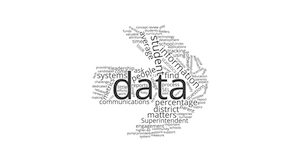
Kick start the new year by getting caught up on the K-12 education discussion. Here are the three trends we expect to shape district growth in 2018 and beyond.
1) The Far-Reaching School Culture
It's refreshing to see so much attention being paid to culture in an environment not always known for it.If you're looking to get caught up, you should know that school culture is comprised of the attitudes, beliefs, expectations, interactions, and overall feeling in a school community, among both internal and external stakeholders. Strong leadership is the most important ingredient, but anyone can become a culture champion.
This topic has come about due to the ripple effect it is having on such overarching topics as school choice and staffing shortages. We noted the six-step process of systemic bias widening the gap between “destination” districts with a strong, healthy culture and those still struggling to get on board. In a nutshell: The best culture attracts the most vocal supporters, which in turn attracts high-performers eager to contribute, which only strengthens the already great culture.
Since culture affects everyone from district leaders to community members, its creation needs to be a group effort. Gathering feedback is a good first step. This free, research-based survey template helps leaders gauge their current culture status with honest, anonymous responses. Just as student assessments give teachers a baseline to grow from, many districts are looking to assess themselves to determine where the most help is needed.
The ecosystem inside and around schools is in a constant state of flux and evolution. Expect the conversations about school culture to continue throughout 2018.
2) Social-Emotional Learning (SEL) Efforts
One component of the Every Student Succeeds Act (ESSA) requires school leaders to measure students' social-emotional learning (SEL) in order to gauge school success. SEL extends far beyond providing encouragement and aims to develop the emotional grit necessary to withstand postsecondary challenges students will inevitably face. SEL skills include building self-esteem, modeling teamwork, developing empathy, and learning conflict resolution strategies, among many others. Cultivating soft skills such as responsible decision-making and self-management is crucial to prepare students for challenges they will encounter after graduation, whether they pursue college or head straight into a career.SEL skills have traditionally been taught on an as-needed, individual, and private basis as students faced personal crises. However, an increasingly divisive political environment has brought these issues to the forefront on a more global level. Students are guaranteed to face stress, anxiety, and tough challenges throughout life. Wouldn't it be great if they knew what to do to cope with these struggles and conquer them?
Plenty of schools have gotten on board with teaching the whole child. This approach begins with a positive school culture designed to provide a healthy, safe environment supported by trusted adults. In this supportive environment, students can flourish academically, socially, and emotionally.
Though ESSA requires it, zero states have actually crafted a plan for measuring SEL. However, a lack of measurement doesn't negate the importance of adding healthy coping behaviors to students' emotional toolboxes. Stay tuned for more discussion in 2018 as districts move toward a more structured approach to SEL.
3) The Growth of School PR Strategies
2018 also brings new opportunities for leaders to take ownership of every school's story and build a strong brand in each community.It's no secret that schools are pillars of the communities they serve. A school offers a place to learn, a gathering space, and a source of pride for students, parents, friends, and neighbors. In many cases, public schools garner particular attention from the community due to funding. It's natural for the public to be curious about the goings-on in their local district.
To create an accurate representation of the positive impact schools are having every day, leaders must invest time and effort to guide the message the community receives. A sustainable public relations strategy is built on substance and transparency—for example, consider this Tweet shared during a teachers’ strike. Crafting a genuine voice, keeping an open mind, and demonstrating humility helps build trust over time within the community. It also doesn't hurt when new families are trying to identify which district or school is the best choice for them, or when high-performing education professionals are looking to take the next step in their careers.
It's important to pinpoint the best way to reach every stakeholder group. When one district identified that 76% of students had a smart device, they shifted their approach to focus on social media. It's easy to think that since messages are shared in cyberspace, PR should fall on the technology department, but resist the temptation to oversimplify. District leaders who entrust a dedicated professional to communicate with the community, especially one trained in public relations, find that representation improves in social and traditional media. Among many public relations tips, appointing a PR and communication professional as the "voice" of a district can help organize and clarify communication between schools and their communities.
It takes dedication to do school PR well. Keeping everyone from district leaders to office staff informed and on-message minimizes confusion, especially in times of crisis. One of the best functions of a dedicated PR professional is the ability to put on the brakes before sharing information to ensure the right message gets out.
Like any communication, school PR can be nuanced and complicated. Look for guidance throughout 2018 to inform district communication strategies.
School culture, SEL, and school PR are just three of the topics leading the way for the education universe in 2018. Stay tuned throughout the year to stay ahead of the conversation and keep driving that positive, lasting change.
Want to stay on top of the latest developments in these and other important topics shaping the K-12 landscape? Subscribe to our monthly Advancing K12 newsletter below.
WHAT'S NEXT FOR YOUR EDTECH? The right combo of tools & support retains staff and serves students better. We'd love to help. Visit skyward.com/get-started to learn more.

|
Erin Werra Blogger, Researcher, and Edvocate |
Erin Werra is a content writer and strategist at Skyward’s Advancing K12 blog. Her writing about K12 edtech, data, security, social-emotional learning, and leadership has appeared in THE Journal, District Administration, eSchool News, and more. She enjoys puzzling over details to make K12 edtech info accessible for all. Outside of edtech, she’s waxing poetic about motherhood, personality traits, and self-growth.




